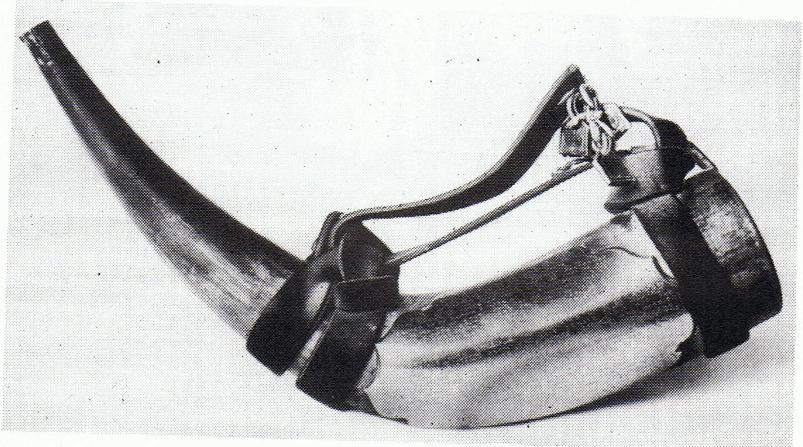

| MENU |

| The Wirral Horn Photograph from the Historic Society of Lancashire & Cheshire |

The Wirral was declared a forest by Randle de Maschines, the 3rd Earl of Chester between 1120 and 1129. With this
new act many new strict laws came into practice. The most notorious of which, was the protection of all deer and game
within the Wirral which was only allowed to be hunted by the Earl or anyone who had been given special permission by
his office. In addition it was forbidden to fell trees, dig pits, grow crops, cultivate land or build dwellings outside of the
designated areas. These laws brought a hatred of the Earls and the laws that followed.
One law which proved extremely unpopular was one which stated that the township and everybody in it was
responsible for any game found dead within the forest and punishments could be spread throughout all of the
residents. Punishments for killing game included blinding with red hot pokers and the amputation of the perpetrators
two bow fingers. To enforce the laws which came with the new status of forest the Earl created the position of Master
Forrester.
The first holder of this position was known as Alan Sylvester who had a tall job enforcing the whole of the peninsula. As
a result he created the position of under-forester to help him enforce these laws. Six people were employed in this post,
all reporting directly to Sylvester. The Abuse of power and the lawlessness in which these enforcer operated are
widespread and highly recorded. Indeed after a short period of time theft, corruption, beatings and blackmail became
regular play in their day to day dealings. To add insult to injury the people who lived within the forest (now the whole
peninsula) had to pay a tax known as "puture", unfortunately for the local population it was the Master Forrester and
his six under-foresters who collected these taxes.
A symbol of authority had to be given to these men, and thus the Earl created what is known as "The Wirral Horn".
The horn was presented to the Master Forrester and still exists today, however its new home is across the Channel in
Jersey. The horn passed down through generations to the Earl of Cromer, descended through the female line of the
Sylvesters who now live on the island. The horn was placed on official documentation related to the Master Forester
and his men and descriptions remain of the foresters uniforms which were said to be emblazed with the Wirral Horn
upon their surcoats.
It is ironic then, that the Horn of Wirral which for hundreds of years was a feared and loathed sign, associated with so
much misery and pain; is now the sign permanently associated with Wirral. The Wirral horn appears on the royal coat of
arms and it is apparent that many people within the peninsula do not know of its origins or uses and the association of
tyranny which it upheld.
new act many new strict laws came into practice. The most notorious of which, was the protection of all deer and game
within the Wirral which was only allowed to be hunted by the Earl or anyone who had been given special permission by
his office. In addition it was forbidden to fell trees, dig pits, grow crops, cultivate land or build dwellings outside of the
designated areas. These laws brought a hatred of the Earls and the laws that followed.
One law which proved extremely unpopular was one which stated that the township and everybody in it was
responsible for any game found dead within the forest and punishments could be spread throughout all of the
residents. Punishments for killing game included blinding with red hot pokers and the amputation of the perpetrators
two bow fingers. To enforce the laws which came with the new status of forest the Earl created the position of Master
Forrester.
The first holder of this position was known as Alan Sylvester who had a tall job enforcing the whole of the peninsula. As
a result he created the position of under-forester to help him enforce these laws. Six people were employed in this post,
all reporting directly to Sylvester. The Abuse of power and the lawlessness in which these enforcer operated are
widespread and highly recorded. Indeed after a short period of time theft, corruption, beatings and blackmail became
regular play in their day to day dealings. To add insult to injury the people who lived within the forest (now the whole
peninsula) had to pay a tax known as "puture", unfortunately for the local population it was the Master Forrester and
his six under-foresters who collected these taxes.
A symbol of authority had to be given to these men, and thus the Earl created what is known as "The Wirral Horn".
The horn was presented to the Master Forrester and still exists today, however its new home is across the Channel in
Jersey. The horn passed down through generations to the Earl of Cromer, descended through the female line of the
Sylvesters who now live on the island. The horn was placed on official documentation related to the Master Forester
and his men and descriptions remain of the foresters uniforms which were said to be emblazed with the Wirral Horn
upon their surcoats.
It is ironic then, that the Horn of Wirral which for hundreds of years was a feared and loathed sign, associated with so
much misery and pain; is now the sign permanently associated with Wirral. The Wirral horn appears on the royal coat of
arms and it is apparent that many people within the peninsula do not know of its origins or uses and the association of
tyranny which it upheld.